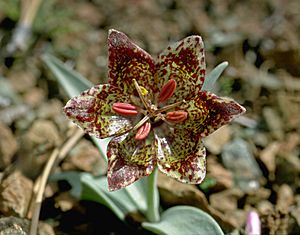Talus fritillary facts for kids
Quick facts for kids Talus fritillary |
|
|---|---|
 |
|
| Scientific classification | |
| Synonyms | |
|
Fritillaria atropurpurea var. falcata Jeps. |
The talus fritillary (scientific name: Fritillaria falcata) is a special kind of flower. It's known for its unique look and where it grows. This plant is a type of fritillary, which is a group of flowering plants.
This plant is found only in California, which means it's endemic to that state. You can find it in just five counties: Monterey, San Benito, Stanislaus, Alameda, and Santa Clara. These counties are located south and east of the San Francisco Bay.
The talus fritillary likes to grow in the Coast Ranges. These are mountains and hills along California's coast. It grows at elevations from about 300 to 1200 meters high. It especially loves to grow on serpentine talus. Serpentine is a type of rock and soil that's common in California. Talus is a pile of broken rocks at the bottom of a cliff or slope.
Sometimes, scientists think this plant might be a smaller group (a subspecies) of another plant called Fritillaria atropurpurea.
What Does the Talus Fritillary Look Like?
The talus fritillary is a small plant. It usually grows a short stem that is about 10 to 20 centimeters tall. That's roughly the length of a pencil!
Around the stem, it has two to six leaves. These leaves are flat and shaped a bit like a sickle, which is a curved farming tool. Each leaf can grow up to about 8 centimeters long.
The flower itself is quite interesting. It stands up straight and looks like a star. It has six tepals, which are like petals and sepals combined. These tepals are about one to two centimeters long. On the outside, they are greenish. But on the inside, they are yellow with cool purple-brown spots and patterns.

